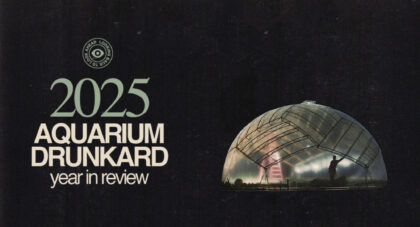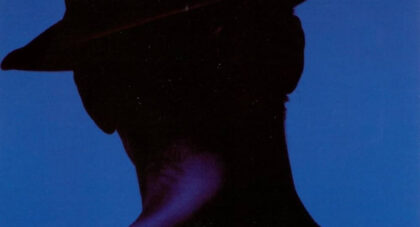Coming off the heels of numerous shows at SXSW (one of which had all of team Drunkard in awe) Akron/Family is primed for the release of their fourth record, Set 'Em Wild, Set 'Em Free (out May 5th on Dead Oceans). AD spoke with Seth Olinsky, guitarist and vocalist with the group during some downtime between tours. Among other things, Olinsky discussed the re-formating of Akron/Family as a three piece, live performance spontaneity, the abundance of ideas that led to their new record, and the groups growing confidence.
Aquarium Drunkard: When Love Is Simple, your last record, was released both you and Miles said that you felt like it was "the end of an era." Do you think that happened, and, if so, what is the new era shaping up to be?
Seth Olinsky: The thing I was referring to… well, Ryan left the band. Ryan was with us since the first record on, and he decided to leave after Love Is Simple, pretty much right after it came out. From then on we started touring as a seven-piece, a six-piece and then eventually as a three-piece. So in a way, he kind of jump-started our process of reinvention and change and forming new ideas.
Why I was originally saying that, before he left the band: we had made the first record (self-titled) and the split LP (with Angels of Light) and Meek Warrior, and with Love Is Simple we felt we’d made something that touched on the things we had made before and incorporated them into one spot. Each of the first three things felt like they went off into different directions, kind of unrelated to each other. And with that record, it felt like we had gotten to the point where we could finally, cohesively, meddle together.
It was the first time we were able to bring all these things together, but also, now that we’ve brought them together we’re gonna have to go out and explore new ideas — that’s a bit of how the record felt. With Ryan leaving, it jumpstarted that whole process of really changing the things of how we wrote songs together, and how we approached recording together. So I do think, in some ways, that Love is Simple was the end of an era and this record in some ways is more a beginning of a new phase.
AD: Do you see Set ‘Em Wild, Set ‘Em Free as a cohesive effort, a culmination of sorts, or that of a number of songs put together?
SO: I think that when we went in to making the record, in some ways there wasn’t a cohesive perspective on what the band sounded like, cause like I said, with Love, without becoming formulaic we had a formula in the four-piece of how we made songs, developed them, recorded them and I think for this one we threw that out the window.
We went into the studio with different material, some slow, some fast, some that we had been playing live as a trio, some that we hadn’t played before at all. And we kinda just started working on everything and trying it different ways so I think the record is the closest to a live show we get because of the way that we’re learning to play together, as three people. I think there’s a reflection of the live show on the record that really is the best we’ve captured yet.
In other ways the record became a grounds for us all to experiment and create together — similar in some ways to our first record. Kind of… creating a blueprint for us to go out and explore as a three-piece, as a new thing.
AD: You have spoken before about how the live experience cultivates your sound, shapes songs and warps them. How much did the transition in a live setting to three pieces transform the way you had to go about changing a song, until it reached it's more final form?
SO: Obviously, for us, the three-piece has been complicated in various ways. We really like our music to have this sonic fullness to it, with a three-piece it tends to be a much more stripped-down sound. And then us learning how to use the space of a three-piece but then also try to use little bits of samplers and drum machines or keyboards or extra instruments so we can create this larger sonic picture.
In some ways, from the beginning as a three-piece, using things like samplers and drum machines or whatever, those things kind of show up in the recording a little bit. I think in a lot of ways, the recording… it’s not like we went out as a three-piece, performed songs and were ready to record them and went to record them. I think the recording ended up us working on working with each other as a three-piece and learning about what kind of sounds we could make together.
For example, Dana (Janssen) plays drums, but he’s also a great singer, great bass player, great guitar player, all these things. In the recording world, we can take advantage of all these things. We spent a lot of time during the recording experimenting and trying out ideas which I think, as opposed to trying out ideas live and then saying it’s a record, we tried things and those are now things we are getting to take advantage of now that we’re touring again.
AD: You’re an admitted Grateful Dead fan, and many see a jamband influence in Akron/Family. How would you describe the journey a song goes through during a show? Is it within very strict confines; is there much room to explore? Are there moments where you plan to stretch it out?
SO: On the overall, I think that certain songs have more space than other songs for opening up into improvisation. I don’t think we totally organize things the way the Dead, or any other modern jambands do, but certain songs we can open up to percussion and can go into different places. Usually I compare it to having a roadmap, and on different nights we can take different routes to get from one place to another.
And some nights, when we’re feeling it, we might make up a whole new… trail blaze a new route and that feels like improvisation. Some nights when, for whatever reason, the crowd’s not feeling it or we’re not linked up… a setlist can be a more stripped version of those songs with less playing around — within the song or from song to song or just the moments that are more open.
We leave ourselves a lot of room and openness within the songs, and how we get from song to song, but there’s not a lot of time where we’re just “jamming” and we have no idea where we’re going and we’re just trying to “jam.” Some nights new things happen and sometimes they don’t. Especially at the beginning of this tour, we were playing new material and these new transitions, so from night to night it would be radically different. One night we would a drone, the next we’d do a percussive thing. We became more familiar with it as the shows went on and the set took shape. By the end of the tour it was more composed.
Continue Reading After The Jump/MP3.....
Only the good shit. Aquarium Drunkard is powered by its patrons. Keep the servers humming and help us continue doing it by pledging your support.
To continue reading, become a member or log in.


